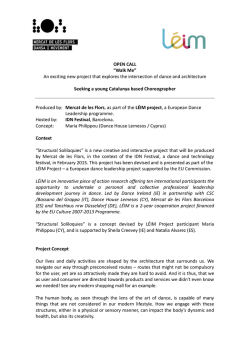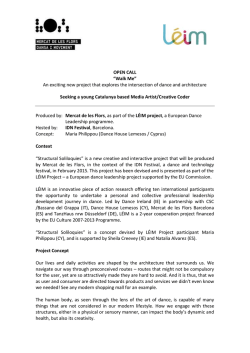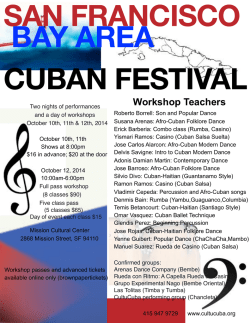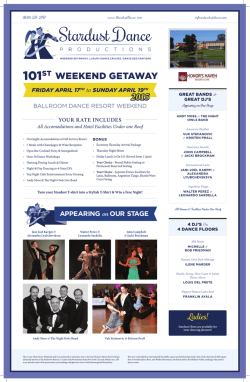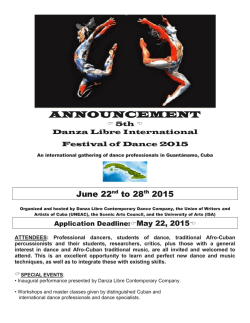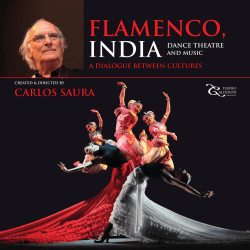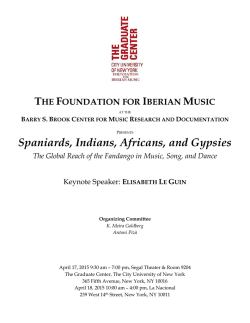
Improving self-rated health in adolescent girls with dance intervention
Improving self-rated health in adolescent girls with dance intervention A randomized controlled trial Duberg, A. R.PT 1, 2, Hagberg, L. Health Economist, Ph.D 1, Sunvisson, H. Ph. D 2, Moeller, M. Professor, R. PT 1,2 1 Centre for Health Care Sciences, Örebro County Council, Sweden, 2Örebro University, Sweden Background: There is an increasing prevalence of psychological health problems among children and adolescents, especially girls. In Sweden, mental illness such as stress and psychosomatic symptoms in adolescent girls is one of the most urgent health problems we face. Knowledge of beneficial effects of regular physical activity on mental health are widespread. Dance is a popular form of exercise also known to increase a sense of self-control which can contribute to reduced stress. Aim: To evaluate if creative dance twice weekly during a period of 8 months is effective in influencing self-rated health in girls with psychosomatic and stress symptoms, 13-18 years old. Inclusion criteria: Girls 13-18 years old seeking school health care for problems such as • • • • • headache pain in the neck, shoulder or back stomach ache sleeping disorders stress, depression Methods: A RCT with a long-term follow-up (2 years), carried out in Sweden. Recruitment was carried out through the school health care. A total of 158 adolescent girls with psychosomatic problems and recurrent experiences of stress were enrolled. The subjects were randomized to either a dance intervention group or control group. Data collection was by questionnaire. The primary outcome was self-rated health (SRH). Several studies have shown that SRH is a strong predictor for morbidity and mortality. The question “In general would you say your health is” is regarded as simple, direct and is assessing unknown perceptions and values related to respondents’ health status in a unique manner. Validity and reliability has been tested [Bjorner J et al. Self-Rated Health – A Useful Concept in Research, Prevention and Clinical Medicine. Swedish council for planning and coordination of research, Report 96:6]. The dance intervention: The dance intervention was carried out twice a week for 75 minutes. The focus was on the joy of movement and not on performance. The theme varied from african dance, showjazz and hip hop to contemporary dance. Creative elements was included and body awareness and relaxation was always part of the class. Results: Compliance to the intervention was 70% and 86% attended the study follow up. The increase in self rated health was significantly higher in the dance intervention group compared to the control group at both follow ups (p= .035 and p= .001). See Table. Explanations to this improvement can possibly be that the dance group experienced an increase in energy and self-esteem. Table. Descriptives for Self Rated Health (SRH). The SRH question is “In general would you say your health is” and the answering alternatives are: 1. Very bad, 2. Bad, 3. Neither good or bad, 4. Good, 5. Very good. Intervention group Control group Mean S D n Mean S D n Value Value Baseline 3.33 (0.87) 57 3.58 8 months 4.06 (0.68) 50 3.93 Change* 0.63 (0.91) 48 0.32 12 months 4.24 (0.78) 49 3.89 Change* 0.83 (0.96) 47 0.27 *= Mean change score relative base line. Conclusion: (0.80) (0.69) (0.77) (0.79) (0.90) P-value for group comparison 101 .057 95 94 .035 90 89 .001 The intervention with dance showed a significant improvement in self rated health compared to the control group. This suggests that a dance intervention twice weekly for 8 months can be suitable for adolescent girls with psychosomatic and stress symptoms. Four months after the intervention the improvement still remained.
© Copyright 2026

